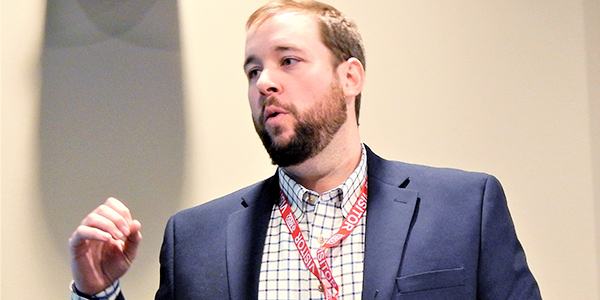By Amanda Durish Cook
The possibility of a MISO–SPP transmission expansion must wait another year, as the RTOs have concluded their third coordinated system plan without recommending a single interregional project.
However, MISO and SPP staff promised they will seek to improve the coordination of their models and make another try in 2020.
The RTOs found no projects for which both would receive at least 5% of the total project benefit, MISO economic planner Gavin Christenson told stakeholders on an Interregional Planning Stakeholder Advisory Committee (IPSAC) conference call Monday.
The RTOs said they were able to “efficiently and effectively” evaluate more than 40 interregional project ideas through each of their regional processes. SPP used two future scenarios, while MISO employed the four future scenarios from its annual Transmission Expansion Plan. SPP requires project candidates demonstrate a 1:1 benefit-to-cost ratio for recommendation, while MISO requires a 1.25:1 ratio.
“While we don’t have a project to approve out of this CSP, it was not because of any process barriers. We still have model differences — this process was designed to take those into account,” SPP’s Adam Bell said.
MISO and SPP reported a smooth changeover to new joint operating agreement rules rolled out this year. The RTOs removed their joint modeling requirement and $5 million cost minimum in addition to calculating the benefits of adjusted production costs (APC) and the avoided cost of other upgrades. Bell said he didn’t notice any “barriers” to the study of potential interregional projects and reported that the RTOs engaged in regular communication throughout.
“We’re comfortable with each set of results. I don’t think these results are any indication that we’ll never have an interregional project,” Bell said. “That’s at least my perspective.”
The lack of interregional projects has long been a topic of debate. The RTOs’ CSP studies in 2014 and 2016 also failed to result in projects. At this month’s Mid-America Regulatory Conference, officials expressed interest in creating a small, interregional project type styled after MISO and PJM’s targeted market efficiency project. (See MISO-SPP Interregional Process Scrutinized at MARC.)
Neosho-Riverton
Christenson promised a “closer look” at seven project proposals that initially showed potential benefits to both SPP and MISO. (See MISO SPP Recommending 2019 CSP, Could Result in 1st Interregional Tx Project.)
Bell thanked MISO for studying so many projects, especially on SPP’s Riverton-Neosho flowgate on the Kansas-Missouri border, where MISO studied nearly two dozen potential solutions. A new 345-kV line to ease the burden on the congested flowgate was one of the seven initially promising proposals.
“Obviously this area has been on our radar, and we wanted to do our due diligence on it,” MISO Interregional Planning Adviser Ben Stearney said of the RTOs’ most expensive flowgate. (See SPP Briefs: M2M Payments from MISO to SPP Eclipse $32M.)
M2M Payment Consideration
Stearney said MISO’s high market-to-market (M2M) payments on the Neosho-Riverton flowgate aren’t captured in APC savings in its model because generation is not redispatched to ease congestion on the line.
“It’s no secret that our APC methodologies have differences,” Stearney said.
Several stakeholders said M2M payments should factor into benefit analyses.
“I don’t understand why the MISO process hasn’t gotten in front of that Neosho-Riverton issue at all,” Missouri Public Service Commission economist Adam McKinnie said.
“This is leaving me concerned that this is not … properly capturing MISO’s cost” to use the flowgate above its firm service, WPPI Energy’s Steve Leovy said. “Unless I’m misunderstanding things, this looks like an appropriate thing to focus on.”
MISO staff promised a closer look at the impact of M2M payments in future interregional studies.
Models, Futures Coordination
Stearney also said the RTOs will pursue better model coordination but cautioned that their separate future scenarios will remain different, “driven by separate stakeholder processes.”
But later in the meeting, RTO staffs said they might consider creating interregional futures to use in the two separate regional reviews.
“Hopefully this thing will build on itself, and each year we’ll have more and more compatible models,” Bell said. “We do think that since we’re doing this annually, we’re going to get a lot better at incorporating everything we can feasibly. … That’s the hope in what this annual process will allow us to do.
“But there’s always going to be a disconnect,” he added.
He said this year, SPP and MISO made sure that the models, although different, “at least made sense.”
“The reasons we’re pointing this out is a sanity check. The [models] do show different benefits. That wasn’t unexpected,” Bell said.
Joint Model Nostalgia?
Advanced Power Alliance’s Steve Gaw asked if some of the modeling mismatch might have been resolved had the RTOs retained their joint model.
Bell said he thought there would be no difference in results with or without a joint model requirement.
“The joint model could have yielded a different result, but the analysis that we just went through would have been exactly the same in the regional review,” Bell said. “We were going to end up right back where we are.”
“You still have the rejection in the regional review. That’s where these projects get thrown out,” Gaw observed, saying he believed the interregional study process may be “broken.”
Bell said there simply wasn’t a project this year that could stand up to all the criteria.
Stearney added that MISO didn’t want to “compromise itself” by lowering the standards in its regional planning process. “We want to make sure projects stand up to criteria established on both sides of the fence,” he said.
MISO and SPP still must create a final, detailed CSP report to present to the IPSAC. The RTO staffs also said they’re taking early steps to begin the 2020 CSP. Representatives from both RTOs asked for stakeholders to submit additional written feedback on suggested improvements to the process.
“This was going to be a takeaway whether we had 10 projects [to recommend] or none — we’re going to improve the process,” Bell said.






